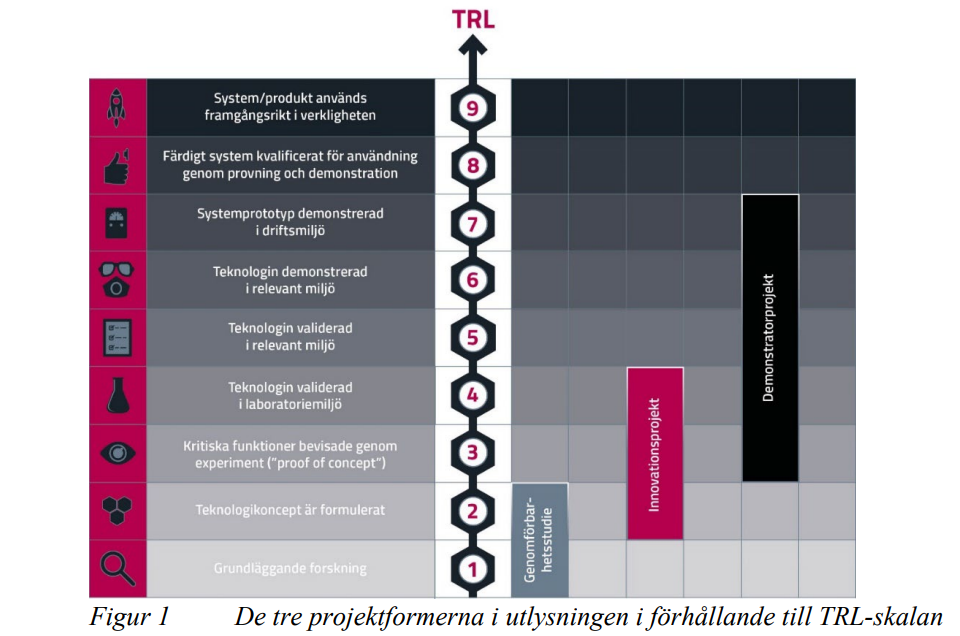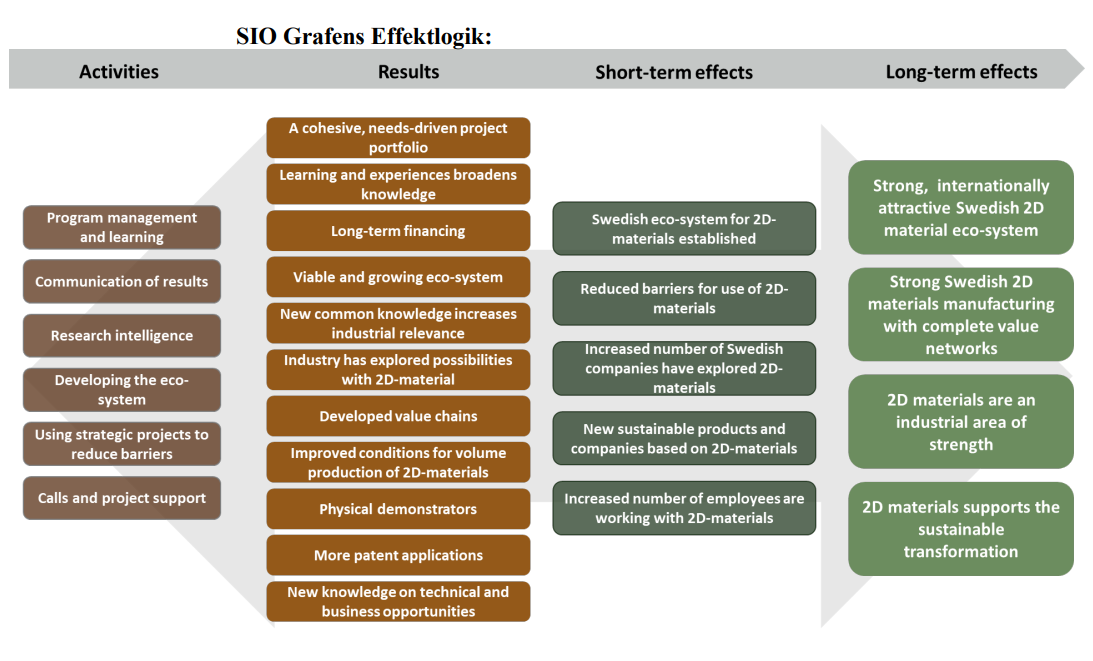SIO Grafen is planning a call for proposals in 2024. After 2024, there are no calls for proposals planned.
You can search for three different types of project:
- Feasibility study
- Innovation project
- Demonstrator project
The project forms support different phases in the development of an idea towards a finished product, and therefore have different eligibility requirements in terms of technology maturity, budget framework and longest time for implementation.
Description of figure 1 below:
It shows how the different project forms relate to the TRL scale. "Technology Readiness Level”, TRL, is a method to show the degree of maturity of a technology.

Feasibility study
To apply for a feasibility study, you need:
- An industrial need.
- An idea for an innovative solution that meets the industrial need with material development linked to graphene or other 2D materials. See definition in Appendix 2.
- A need to clarify technical, market or intellectual property conditions.
- At least two parties, of which at least one is a Swedish company.
- A company in the project group that intends to implement the project's results in future activities.
Activities in the project can be, for example:
- To do an in-depth literature study.
- Doing experimental or theoretical studies to verify the idea.
- To investigate market potential or patent landscape.
- To evaluate the need for reinforcement in the value chain for future activities.
Expected results:
- The project's technology maturity has been raised to at least TRL 2.
- You know whether the concept has technical and market potential to be further developed, for example in a new project application.
- You know which issues need to be resolved.
- You have a first idea of how the results can be implemented.
- You know which actors are needed to develop the value chain in a new project.
Maximum funding is SEK 300,000.
Maximum project time is 9 months.
Innovation project
To apply for an innovation project, you need:
- An industrial need.
- An innovative solution of at least TRL 2 that meets the industrial need with graphene or other 2D material. See definition in Appendix 2.
- Identified knowledge gaps that require material development, concept development and testing before the concept can proceed towards commercialization.
- At least three parties along a value chain, of which at least two are companies.
- At least one Swedish company must be part of the project group.
- A company in the project group that intends to implement the project's results in future activities.
Activities in the project can be, for example:
- To develop and characterize materials.
- To simulate and to validate the simulation.
- To develop concepts for testing in a lab environment.
- To develop manufacturing processes.
- To validate the concept in a lab environment.
Expected results:
- The project has raised the TRL level at least one step.
- You know what functionality and industrial potential your concept has.
- You have created knowledge beyond the existing "state-of-the-art" about graphene or
other 2D materials and their applications. - You have a plan for how the results can be implemented.
- You know if new actors are needed to strengthen the value chain.
Maximum funding is SEK 1,500,000.
Maximum project time is 18 months.
Demonstrator project
To apply for a demonstrator project, you need:
- An industrially relevant concept that is at least TRL 3. The concept must be based on graphene or some other 2D material. See definition in Appendix 2.
- At least three parties along a value chain, of which at least two are companies.
- At least one Swedish company must be part of the project group.
- A company in the project group that intends to implement the project's results in future activities.
Activities in the project can be, for example:
- To produce a physical prototype.
- To validate in a lab environment or simulated environment.
- To demonstrate in simulated environment or real environment.
- To develop new concepts for manufacturing and scale-up processes.
Expected results:
- The project has raised the TRL level at least two steps.
- You have validated your concept in a relevant environment, i.e. reached at least TRL 5.
- You have produced a physical demonstrator.
- You have created knowledge beyond the existing "state-of-the-art" about graphene or other 2D materials and their applications.
- You know how the results should be implemented and communicated.
- You have the value chain in place.
Maximum funding is SEK 3,000,000.
Maximum project time is 30 months.



